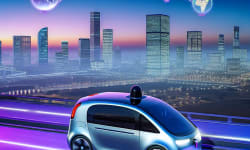
How Fiber Optics Are Revolutionizing Train Monitoring
Discover how fiber optics, originally used for internet connectivity, are now being utilized to monitor train activity. Learn how this technology is transforming the transportation industry.

Date: Nov 20, 2025
Category: Transportation
Self-driving vehicles are rapidly transitioning from science fiction to everyday reality, thanks to innovative companies like Waymo—the autonomous driving division of Alphabet, Google's parent company. On Tuesday, Waymo announced a major expansion: it will deploy its fully autonomous robotaxi service in five new cities, marking a significant milestone in the evolution of urban transportation. Currently, Waymo operates its driverless ride-hailing service in select areas of Phoenix, San Francisco, and Los Angeles. With this latest announcement, the company is set to broaden its reach, bringing its cutting-edge technology to even more urban environments. The five new cities slated for Waymo's autonomous service rollout include [insert city names if available], each chosen for their unique transportation needs and infrastructure readiness. Waymo's robotaxis are equipped with advanced sensors, machine learning algorithms, and rigorous safety protocols, allowing them to navigate complex city streets without a human driver. This expansion reflects growing confidence in autonomous vehicle technology and its potential to revolutionize mobility, reduce traffic accidents, and provide convenient, on-demand transportation. Here's a breakdown of where Waymo currently operates, the new cities joining its network, and what this means for the future of self-driving cars: - **Current Waymo Service Areas:** Phoenix, San Francisco, Los Angeles - **New Expansion Cities:** [List the 5 new cities] - **Key Features:** Fully autonomous operation, no safety driver required, 24/7 availability in select zones - **Future Plans:** Continued expansion to additional cities, ongoing improvements to safety and user experience As Waymo continues to push the boundaries of autonomous mobility, commuters and city planners alike are watching closely. The rollout in these new cities will serve as a critical test for the scalability and public acceptance of robotaxi services nationwide. Stay tuned for updates on Waymo's expansion and the latest developments in self-driving technology. Read the source »
Share on:

Discover how fiber optics, originally used for internet connectivity, are now being utilized to monitor train activity. Learn how this technology is transforming the transportation industry.

KLM partners with ZeroAvia to pioneer a liquid hydrogen-powered turboprop aircraft, targeting a flight demonstration in 2026.

Pegasus Aerospace introduces a groundbreaking hybrid flying car that combines highway speeds with a flight range of 300 miles, offering up to three hours of airborne travel before needing to refuel.

Uber strategically invests in Wayve, aiming to capitalize on the mainstream adoption of autonomous vehicles, extending Wayve’s impressive $1 billion funding round.

Discover the Swift Pod, a groundbreaking autonomous vehicle that combines the comfort of a hotel with the convenience of a car, offering a seamless travel experience.

Discover why the mobility transition is a unique asset class and learn strategies to mitigate investment risks from industry experts.